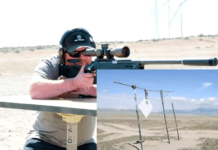Notice how Kenny Wayne Miller raises and lowers his gun like a fishing rod. “Fishing” isn’t just inefficient. It’s a clear violation of the safety rule “Never point the muzzle of the gun at anything you don’t want to destroy.” What’s the harm in pointing a bullet skywards? Plenty of people have been killed by bullets fired into the air in celebration. The same applies, at least potentially, to bullets fired in the air because of improper technique. Notice that Mr. Miller’s finger is on the trigger throughout his fishing expedition. That’s another no-no; your finger should go on the trigger AFTER you’ve aimed the gun. Not before or during. More bad technique . . .
After Mr. Miller shoots, he lets his arms bob up and down like they’re on springs. That’s an excellent technique for novice shooters trying to get comfortable with recoil. But once you’ve made your peace with having something explode in your hand (snap caps are your friend), you need to tighten up everything: grip, shoulders and arm muscles. Tight muscles improve accuracy and reduce muzzle flip, allowing for quicker and more accurate follow-up shots. Leaning forward from the hips wouldn’t hurt, either.
Look how Mr. Miller reacts after he’s done firing. Even before he takes the gun off the target, he’s brought his attention towards the camera (:14). If I was the camera man I would be VERY nervous. At :15 in, he half-slips. At :16, he brings the gun towards his left hand. A fraction of a second later, he abandons the move. He then tilts the gun to examine it. And tilts it again, so that it’s almost pointing at his chest. As far as I can tell, his finger is still on the trigger.
Generally speaking, Mr. Miller is waving the gun around indiscriminately. His movements lack focus, planning or precision. It’s what you’d call—without fear of contradiction—sloppy gun handling. Which is entirely irresponsible. Sloppy gun handling shows a callous disregard for safety, both the shooter’s and anyone unlucky enough to be around them. If you buy a gun, train how to use it—before, during and after firing. Otherwise, it’s only a matter of time before something bad happens.




Thanks for posting these vivid examples of what not to do. I’ll bet your readers have benefited from them.
Lot of smarts in that poistng!
I’ve been looking for a post like this forever (and a day)
I’m so glad that the internet allows free info like this!
Comments are closed.